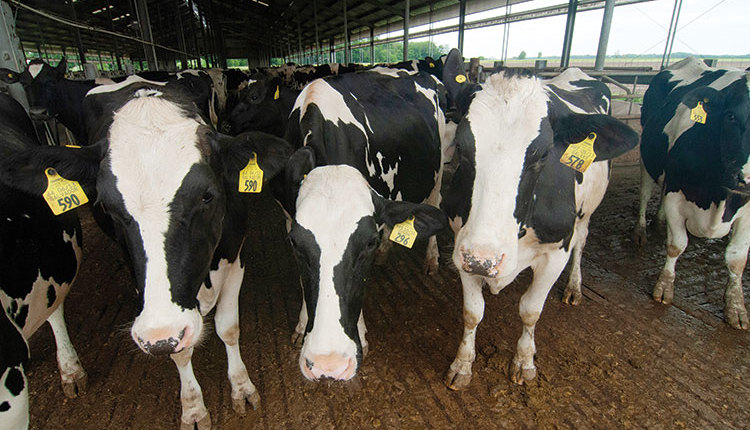The author is a professor of animal sciences at Kansas State University, Manhattan.
In 1979, the first prostaglandin product, commercially known as Lutalyse, came to the marketplace. It allowed veterinarians and farmers new opportunities to manage the estrous cycle by inducing estrus in lactating dairy cows. This new biotechnology also meant that we could induce heat at our convenience, allowing synchronized females to be inseminated during the regular work week.
For example, administering prostaglandin to cows or heifers on Monday mornings would allow for most females to show heat in two to five days. With the most heats occurring on Thursdays. Of course, females near the end of their cycle, whose corpus luteum (CL) is regressing spontaneously, may come into heat before two days. This biotechnology led to the so-called “Monday morning” programs.
With prostaglandin, cows could receive the product once diagnosed open at preg check — those with a palpable CL — expecting that they should come into heat during the next few days. Certainly, this technology depended on each herd veterinary practitioner’s ability to correctly diagnose a functional CL, or in other words, an active CL that is producing progesterone.
Palpation accuracy a must
Because of the importance of accurately diagnosing a functional CL, a number of early research studies were conducted to determine the accuracy of palpating a CL. Studies conducted between 1980 and 1989 established two important principles (Figure 1). When a CL existed in one of the ovaries, based on either actual visual inspection at slaughter or laboratory analyses of progesterone in the blood or milk of the cow, experienced palpators were 72 to 90 percent (average = 82 percent) accurate in detecting a functional CL.

In contrast, when no CL existed in one of the ovaries, again based on inspection or lab results, experienced palpators were only 49 to 72 percent (average = 63.4 percent) accurate in diagnosing cows with no CL. Therefore, more mistakes were made in identifying cows without a CL than identifying cows with a CL.
Because of these diagnostic errors, it was assumed that when cows did not come into heat after receiving a prostaglandin injection that heat detection was faulty. In reality, the fault lied in both the incorrect diagnosis and the heat detection when the diagnosis was right.
Later, when ultrasound became more commonly used by both practitioners and on-farm technicians, additional research helped examine its accuracy when identifying cows with a functional CL versus those not having a CL.

Figure 2 summarized six studies conducted on different farms by different technicians. Accuracy of detecting a cow with a functional CL, based on laboratory progesterone analyses, ranged from 78 to 100 percent (average = 88 percent), slightly more accurate than results based on physical palpation of a CL.
What may be surprising to some, research showed that the accuracy of diagnosing a cow with no CL ranged from 20 to 52 percent (average = 43 percent); actually less accurate than palpation. Even when one can see the CL via ultrasound, it is still difficult to determine if the CL is functional, which means it is producing progesterone.
Errors with no CLs
Why are more errors made in diagnosing cows with no CL than cows with a CL?
One-time snapshots of the ovaries can be deceiving. A practitioner may examine a cow today and not identify a new CL, but 48 hours later the new CL is evident. Most of our mistakes are made in cows that are approaching estrus or have recently ovulated.
Color or echotexture of the CL is often helpful because functional CL usually are more “salt and peppery” in appearance and larger in diameter when they are functional. One study showed that the accuracy of CL detection by ultrasound improved significantly as concentrations of progesterone increased.
Size also is important.
One study demonstrated that CL diameter was important to the accuracy of diagnosing a functional CL. When a CL was assessed using a cutoff diameter of 23 mm at 21 days and 22 mm at 24 days after breeding, the accuracy improved markedly. The sensitivity and specificity both improved to the mid to high 80 percent range when the CL size cutoff values of 22 to 23 mm were part of the diagnosis.
As a refresher, sensitivity answers the question: “If a cow has a CL, how often is that true?” Meanwhile, specificity centers on the question, “If a cow does not have a CL, how often is that true?”
Making these diameter estimates is facilitated by calibrated grids on most ultrasound screens. Furthermore, dairy veterinary practitioners with more than three years of experience were much more accurate than their less-experienced peers.
Accurately assessing CL status likely is more important in dairies that have poor heat detection. Because cows show better heats in drylot or pasture dairies, assessing CL status may have greater value on dairies with cows in confinement facilities with concrete floors.
Some research supports the fact that subsequent fertility of open cows without a CL may improve by applying a progesterone insert (CIDR or PRID) with the timed breeding program. That program is GnRH plus an insert for seven days, prostaglandin 56 hours thereafter, and GnRH 16 hours later followed by A.I.
All tools have inherent errors, so it is important to realize that no technique or technology is 100 percent accurate. As in life, we must learn to manage our weaknesses to become better people and better reproductive managers of cows. Happy A.I. breeding!










